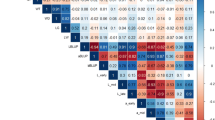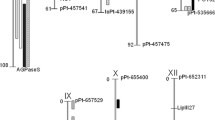Abstract
There is a growing niche market for coloured-skin potatoes, and breeders are developing new cultivars that not only exhibit coloured tuber skin but are also improved for agronomic and nutritional traits. Molecular markers provide a mechanism to increase the efficiency of such breeding programmes through marker-assisted selection (MAS) of both parents and elite seedlings in breeding populations. In our study, we used next-generation sequencing and high-resolution DNA melting (HRM) to develop single nucleotide polymorphism (SNP)-based markers from candidate genes associated with tuber skin colour in tetraploid potato, including small amplicon assays and dosage-sensitive unlabelled probes. We present SNP-based HRM markers for Stan2 and Stan3 (D locus), dfr (R locus) and f3′5′h (P locus) as predictors of tuber skin colour in potato, employing a genetic resource of 19 parental accessions for marker development and then demonstrating their application in three segregating populations. To our knowledge, this is not only the first report of HRM unlabelled probe and short amplicon assays at the D locus, but also the first report of the implementation of MAS for tuber skin colour, using a combination of markers at the D, R and P loci. Our estimation of allele dosage for these genes highlights the usefulness of this methodology for parental selection targeting oligogenic traits.



Similar content being viewed by others
References
Asano K, Kobayashi A, Tsuda S, Nishinaka M, Tamiya S (2012) DNA marker-assisted evaluation of potato genotypes for potential resistance to potato cyst nematode pathotypes not yet invading into Japan. Breed Sci 62(2):142–150. https://doi.org/10.1270/jsbbs.62.142
Barrell PJ, Meiyalaghan S, Jacobs JME, Conner AJ (2013) Applications of biotechnology and genomics in potato improvement. Plant Biotechnol J 11(8):907–920. https://doi.org/10.1111/pbi.12099
Bernatzky R, Tanksley SD (1986) Genetics of actin-related sequences in tomato. Theor Appl Genet 72:314–339
Bormann CA, Rickert AM, Ruiz RAC, Paal J, Lubeck J, Strahwald J, Buhr K, Gebhardt C (2004) Tagging quantitative trait loci for maturity-corrected late blight resistance in tetraploid potato with PCR-based candidate gene markers. Mol Plant-Microbe Interact 17(10):1126–1138. https://doi.org/10.1094/Mpmi.2004.17.10.1126
Chao S, Somers D (2012) Wheat and barley DNA extraction in 96-well plates; WheatMAS. http://maswheat.ucdavis.edu/protocols/general_protocols/DNA_extraction_003.htm. Accessed 10th July 2012
Collard BC, Mackill DJ (2008) Marker-assisted selection: an approach for precision plant breeding in the twenty-first century. Philos Trans R Soc Lond Ser B Biol Sci 363(1491):557–572. https://doi.org/10.1098/rstb.2007.2170
Colton LM, Groza HI, Wielgus SM, Jiang J (2006) Marker-assisted selection for the broad-spectrum potato late blight resistance conferred by gene derived from a wild potato species. Crop Sci 46(2):589–594. https://doi.org/10.2135/cropsci2005.0112
Dames S, Margraf RL, Pattison DC, Wittwer CT, Voelkerding KV (2007) Characterization of aberrant melting peaks in unlabeled probe assays. J Mol Diagn 9(3):290–296. https://doi.org/10.2353/jmoldx.2007.060139
De Jong WS, De Jong DM, De Jong H, Kalazich J, Bodis M (2003) An allele of dihydroflavonol 4-reductase associated with the ability to produce red anthocyanin pigments in potato (Solanum tuberosum L.). TAG Theor Appl Genet 107(8):1375–1383. https://doi.org/10.1007/s00122-003-1395-9
De Koeyer D, Douglass K, Murphy A, Whitney S, Nolan L, Song Y, De Jong W (2010) Application of high-resolution DNA melting for genotyping and variant scanning of diploid and autotetraploid potato. Mol Breed 25(1):67–90. https://doi.org/10.1007/s11032-009-9309-4
Dodds KS, Long DH (1955) The inheritance of colour in diploid potatoes. J Gen 53(1):136–149. https://doi.org/10.1007/BF02981517
Drummond A, Ashton B, Buxton S, Cheung M, Cooper A, Duran C, Field M, Heled J, Kearse M, Markowitz S, Moir R, Stones-Havas S, Sturrock S, Thierer T, Wilson A (2012) Geneious v6.1. http://www.geneious.com. Accessed 29 Nov 2018
Fulladolsa A, Navarro F, Kota R, Severson K, Palta J, Charkowski A (2015) Application of marker assisted selection for potato virus Y resistance in the University of Wisconsin Potato Breeding Program. Am J Potato Res 92:1–7. https://doi.org/10.1007/s12230-015-9431-2
Gebhardt C, Bellin D, Henselewski H, Lehmann W, Schwarzfischer J, Valkonen JP (2006) Marker-assisted combination of major genes for pathogen resistance in potato. Theor Appl Genet 112(8):1458–1464. https://doi.org/10.1007/s00122-006-0248-8
Hämäläinen JH, Watanabe KN, Valkonen JPT, Arihara A, Plaisted RL, Pehu E, Miller L, Slack SA (1997) Mapping and marker-assisted selection for a gene for extreme resistance to potato virus Y. Theor Appl Genet 94(2):192–197. https://doi.org/10.1007/s001220050399
De Jong H (1991) Inheritance of anthocyanin pigmentation in the cultivated potato - a critical-review. Am Potato J 68(9):585–593
Jung CS, Griffiths HM, De Jong DM, Cheng S, Bodis M, De Jong WS (2005) The potato P locus codes for flavonoid 3′,5′-hydroxylase. Theor Appl Genet 110(2):269–275. https://doi.org/10.1007/s00122-004-1829-z
Jung CS, Griffiths HM, De Jong DM, Cheng S, Bodis M, Kim TS, De Jong WS (2009) The potato developer (D) locus encodes an R2R3 MYB transcription factor that regulates expression of multiple anthocyanin structural genes in tuber skin. Theor Appl Genet 120(1):45–57. https://doi.org/10.1007/s00122-009-1158-3
Kasai K, Morikawa Y, Sorri VA, Valkonen JP, Gebhardt C, Watanabe KN (2000) Development of SCAR markers to the PVY resistance gene Ryadg based on a common feature of plant disease resistance genes. Genome 43(1):1–8
Li H, Durbin R (2009) Fast and accurate short read alignment with Burrows–Wheeler transform. Bioinformatics 25(14):1754–1760. https://doi.org/10.1093/bioinformatics/btp324
Li H, Handsaker B, Wysoker A, Fennell T, Ruan J, Homer N, Marth G, Abecasis G, Durbin R, Subgroup GPDP (2009) The sequence alignment/map (SAM) format and SAMtools. Bioinformatics 25:2078–2079. https://doi.org/10.1093/bioinformatics/btp352
Liew M, Pryor R, Palais R, Meadows C, Erali M, Lyon E, Wittwer C (2004) Genotyping of single-nucleotide polymorphisms by high-resolution melting of small amplicons. Clin Chem 50(7):1156–1164. https://doi.org/10.1373/clinchem.2004.032136
Luo ZW, Hackett CA, Bradshaw JE, McNicol JW, Milbourne D (2001) Construction of a genetic linkage map in tetraploid species using molecular markers. Genetics 157(3):1369–1385
McCord P, Zhang L, Brown C (2012) The incidence and effect on total tuber carotenoids of a recessive zeaxanthin epoxidase allele (Zep1) in yellow-fleshed potatoes. Am J Potato Res 89(4):262–268. https://doi.org/10.1007/s12230-012-9250-7
Meiyalaghan S, Thomson S, Fiers MWEJ, Barrell PJ, Latimer JM, Mohan S, Jones EE, Conner AJ, Jacobs JME (2014) Structure and expression of GSL1 and GSL2 genes encoding gibberellin stimulated-like proteins in diploid and highly heterozygous tetraploid potato reveals their highly conserved and essential status. BMC Genomics 15:2. https://doi.org/10.1186/1471-2164-15-2
Meiyalaghan S, Paget M, Thompson S, Thomson S, Baldwin S, Anderson J, Genet R, Lewthwaite S (2018) High resolution DNA melting markers for identification of H1-linked resistance to potato cyst nematode. Mol Breed 38(6):79. https://doi.org/10.1007/s11032-018-0832-z
Moloney C, Griffin D, Jones PW, Bryan GJ, McLean K, Bradshaw JE, Milbourne D (2010) Development of diagnostic markers for use in breeding potatoes resistant to Globodera pallida pathotype Pa2/3 using germplasm derived from Solanum tuberosum ssp. andigena CPC 2802. Theor Appl Genet 120(3):679–689. https://doi.org/10.1007/s00122-009-1185-0
Obidiegwu JE, Sanetomo R, Flath K, Tacke E, Hofferbert H-R, Hofmann A, Walkemeier B, Gebhardt C (2015) Genomic architecture of potato resistance to Synchytrium endobioticum disentangled using SSR markers and the 8.3k SolCAP SNP genotyping array. BMC Genet 16(1):38. https://doi.org/10.1186/s12863-015-0195-y
Ottoman RJ, Hane DC, Brown CR, Yilma S, James SR, Mosley AR, Crosslin JM, Vales MI (2009) Validation and implementation of marker-assisted selection (MAS) for PVY resistance (Ry adg gene) in a tetraploid potato breeding program. Am J Potato Res 86(4):304–314. https://doi.org/10.1007/s12230-009-9084-0
Ramakrishnan A, Ritland C, Blas Sevillano R, Riseman A (2015) Review of potato molecular markers to enhance trait selection. Am J Potato Res 92:1–18. https://doi.org/10.1007/s12230-015-9455-7
Robinson JT, Thorvaldsdottir H, Winckler W, Guttman M, Lander ES, Getz G, Mesirov JP (2011) Integrative genomics viewer. Nat Biotechnol 29(1):24–26. https://doi.org/10.1038/nbt.1754
Schultz L, Cogan NOI, McLean K, Dale MFB, Bryan GJ, Forster JW, Slater AT (2012) Evaluation and implementation of a potential diagnostic molecular marker for H1-conferred potato cyst nematode resistance in potato (Solanum tuberosum L.). Plant Breed 131(2):315–321. https://doi.org/10.1111/j.1439-0523.2012.01949.x
Seipp MT, Durtschi JD, Liew MA, Williams J, Damjanovich K, Pont-Kingdon G, Lyon E, Voelkerding KV, Wittwert CT (2007) Unlabeled oligonucleotides as internal temperature controls for genotyping by amplicon melting. J Mol Diagn 9(3):284–289. https://doi.org/10.2353/jmoldx.2007.060136
Sharma SK, Bolser D, de Boer J, Sønderkær M, Amoros W, Carboni MF, D'Ambrosio JM, de la Cruz G, Di Genova A, Douches DS, Eguiluz M, Guo X, Guzman F, Hackett CA, Hamilton JP, Li G, Li Y, Lozano R, Maass A, Marshall D, Martinez D, McLean K, Mejía N, Milne L, Munive S, Nagy I, Ponce O, Ramirez M, Simon R, Thomson SJ, Torres Y, Waugh R, Zhang Z, Huang S, Visser RGF, Bachem CWB, Sagredo B, Feingold SE, Orjeda G, Veilleux RE, Bonierbale M, Jacobs JME, Milbourne D, Martin DMA, Bryan GJ (2013) Construction of reference chromosome-scale pseudomolecules for potato: integrating the potato genome with genetic and physical maps. G3 3:2031–2047. https://doi.org/10.1534/g3.113.007153
Sliwka J, Jakuczun H, Kaminski P, Zimnoch-Guzowska E (2010) Marker-assisted selection of diploid and tetraploid potatoes carrying Rpi-phu1, a major gene for resistance to Phytophthora infestans. J Appl Genet 51(2):133–140
The Potato Genome Sequencing Consortium (2011) Genome sequence and analysis of the tuber crop potato. Nature 475(7355):189–195
Van Eck HJ, Jacobs JME, van Dijk J, Stiekema WJ, Jacobsen E (1993) Identification and mapping of 3 flower color loci of potato (Solanum tuberosum L) by RFLP analysis. Theor Appl Genet 86(2–3):295–300
Van Eck HJ, Jacobs JME, Van Den berg PMMM, Stiekema WJ, Jacobsen E (1994) The inheritance of anthocyanin pigmentation in potato (Solanum tuberosum L) and mapping of tuber skin color loci using RFLPs. Heredity 73:410–421
Wittwer CT, Reed GH, Gundry CN, Vandersteen JG, Pryor RJ (2003) High-resolution genotyping by amplicon melting analysis using LCGreen. Clin Chem 49(6):853–860. https://doi.org/10.1373/49.6.853
Zhang Y, Cheng S, De Jong D, Griffiths H, Halitschke R, De Jong W (2009) The potato R locus codes for dihydroflavonol 4-reductase. Theor Appl Genet 119(5):931–937. https://doi.org/10.1007/s00122-009-1100-8
Acknowledgements
We thank John Anderson for developing the populations 5516, 5519 and 5520; Donna Gibson for the illustrations; Dr. Susan Gardiner and Dr. Philippa Barrell for comments on earlier drafts of the manuscript; and the International Potato Centre, Lima, Peru for providing the DM DNA. This work was supported through the New Zealand Strategic Science Investment Fund (SSIF) Potato Molecular Breeding programme, managed by The New Zealand Institute for Plant and Food Research Limited.
Availability of data
454 sequencing data have been deposited at GenBank (https://www.ncbi.nlm.nih.gov) under the accession PRJNA524395.
Author information
Authors and Affiliations
Corresponding author
Additional information
Publisher’s note
Springer Nature remains neutral with regard to jurisdictional claims in published maps and institutional affiliations.
Rights and permissions
About this article
Cite this article
Meiyalaghan, S., Thomson, S., Kenel, F. et al. Development and application of high-resolution melting DNA markers for the polygenic control of tuber skin colour in autotetraploid potato. Mol Breeding 39, 99 (2019). https://doi.org/10.1007/s11032-019-1009-0
Received:
Accepted:
Published:
DOI: https://doi.org/10.1007/s11032-019-1009-0




